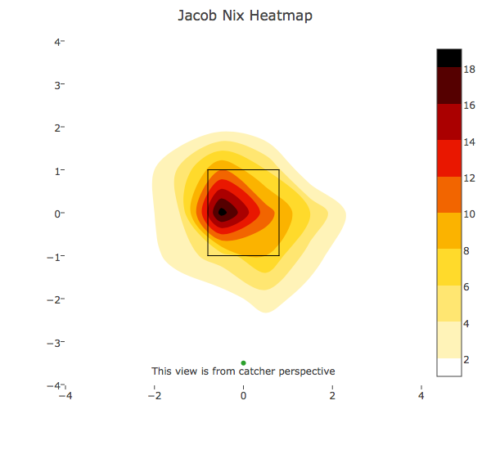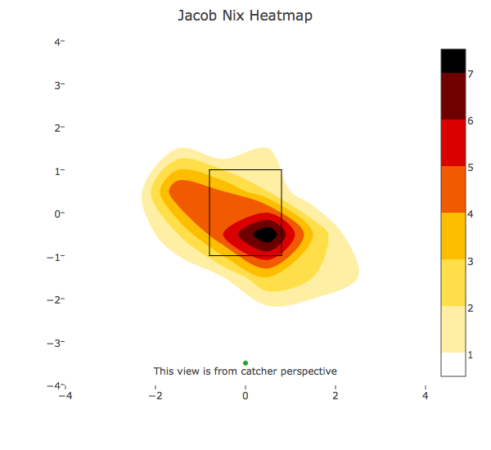Understanding Where Things Went Wrong for Jacob Nix


The first major league start of Jacob Nix‘s career was outstanding on August 10th, as he threw six shutout innings.
On Thursday versus the Diamondbacks, his start was horrendous.
What makes the whole situation so intriguing is the volatility in Nix’s two performances — it’s like we’ve seen the best of him, and then the worst version of Nix in the span of his first two big league starts.
What went wrong, and why did things go downhill so quickly for him in comparison to his first start?
That’s what we’d like to explore here.
To start, let’s look at the more raw data on the quality of the stuff he was throwing. This basically is a question of how hard he was throwing, how well his pitches moved, among other things, when we talk about quality of ‘stuff.’
Here’s some data on Nix’s stuff from Brooks Baseball on his strong start versus the Phillies on August 10th:
| Type | Velo (Max) | H-Break | V-Break | Count |
| FA (Fastball) | 94.4 (96.5) | -6.04 | 8.88 | 57 |
| CH (Changeup) | 81.4 (83.5) | -10.44 | 1.79 | 12 |
| CU (Curveball) | 77.3 (79.9) | 4.64 | -6.65 | 19 |
As we know, his quality of stuff was nasty enough to get him through six shutout innings — he gave up two hits on his fastball and two on his curveball, but none off his changeup in his debut. All his pitches were working well, especially in the case of his changeup. The horizontal break on his pitches is impressive, as his changeup, for example, has a lot of what we call ‘fade.’ If only his pitches could have been of the same quality when he threw against the Diamondbacks on Thursday:
| Type | Velo (Max) | H-Break | V-Break | Count |
| FA (Fastball) | 94.0 (95.5) | -5.9 | 9.54 | 30 |
| CH (Changeup) | 81.7 (82.2) | -10.08 | 1.66 | 5 |
| CU (Curveball) | 78.4 (80.0) | 3.94 | -7.29 | 7 |
The fastball stands out because it wasn’t as hard, so hitters had more time in his second start to recognize the pitch and react to it. It also didn’t break as much horizontally, though it did have more vertical break than in his first time out. The increase in vertical break didn’t help him though, as his command let him down — four of the five first inning hits Nix allowed were off his fastball. All the run-scoring hits he allowed were off his fastball, and even his changeup was smacked for a base hit in the same inning. His stuff was down in the second start, in terms of velocity and movement, which was the first part of what went wrong for him in his most recent outing. We can’t forget where he located pitches though, which is also highly important to analyze.
We want to see if Nix threw pitches in noticeably different locations from start to start, and potentially use that as further evidence for his struggles the second time out. First, here are the Statcast locations of his pitches during his first start:

He threw a lot of inside pitches during his outing against the Phillies, and this was important in him being successful during that game. Another thing to note was his ability to just throw strikes consistently during that game, as we can see that most of his pitches were in and around the strike zone. Later on in his next start, the locations of his pitches were certainly different:

For a lot of pitchers, hitting the outside corner more often leads to an improvement in their performance. Apparently, the same can’t be said of Jacob Nix, who was roughed up in the start in which he did a better job of doing just that. More important is the fact that he threw more pitches out of the zone, and of course over the heart of the plate. Nix fell behind too many hitters in his second start, and then threw pitches over the middle of the zone trying to come back, only to have them hit hard by the D-Backs’ lineup.
Where else can we look to find more answers as to why he struggled? The umpire’s strike zone was also a factor that didn’t seem to help Nix in his most recent start. Nix allowed four of the five hits on August 16th to lefties, and three of the four hits he surrendered in his debut were to left-handed batters. We want to see if the zone the umpire called made it even more difficult for Nix to get lefties out, whom he struggles more with. Using Brooks Baseball data again, here are the Umpire Zones called in each start when left-handed batters were up:
There were noticeably more strikes called on the outside part of the plate for Nix when he faced the Phillies, in comparison to the start on the 16th versus the Diamondbacks. So we can conclude that while he didn’t pitch well anyway, the umpire for his second start was less generous about calling outside strikes, which only worsened things for his performance. We aren’t trying to make up excuses for Nix, but we’re acknowledging that the umpires had a role in his struggles on the mound on Thursday.
There was a lot that went wrong for Jacob Nix in his last outing, and we’ve gone over why it happened and how it occurred. In the context of his career though, some growing pains are perfectly acceptable at this point — Nix is the youngest player on the roster at age 22 (Jose Castillo was born a day later). As a 2015 draftee, this is a guy who has already done very well to make it to the big leagues. It’s a rebuilding season, so letting Nix work out the kinks is something the team should be happy to do. Development is not linear, and Jacob Nix hit a bump in the road on Thursday. Overall, his future still looks pretty promising.
A sophomore at Willamette University in Oregon, Conrad is majoring in Spanish but is also a writing center assistant for other students at Willamette. He has been a Padres die-hard his whole life and hopes to bring comprehensible statistical analysis to the site.